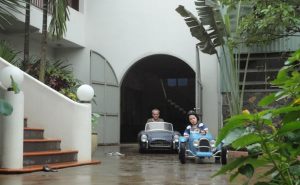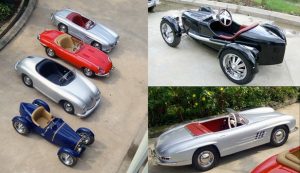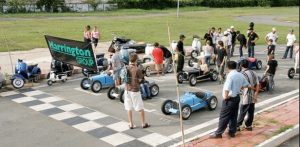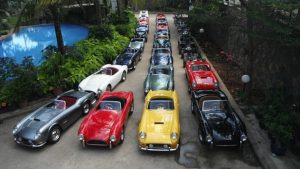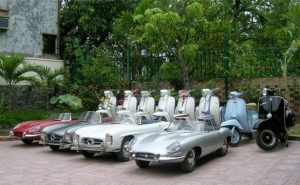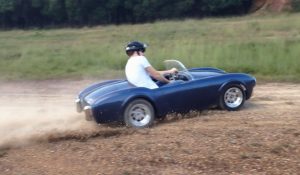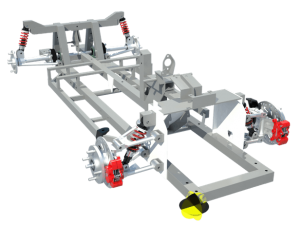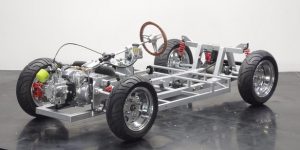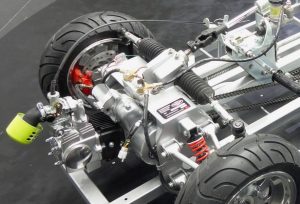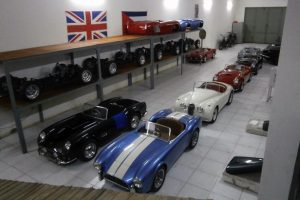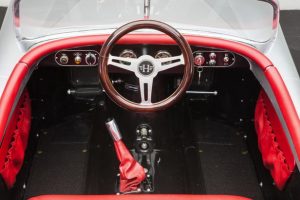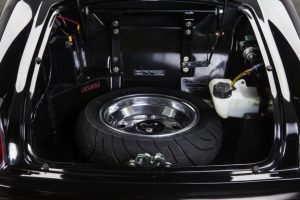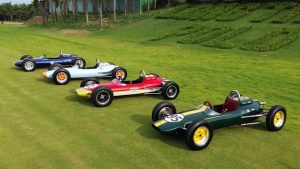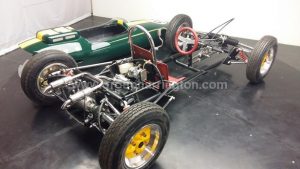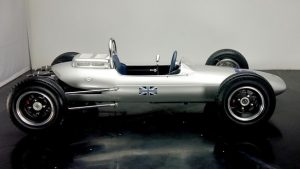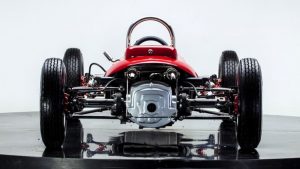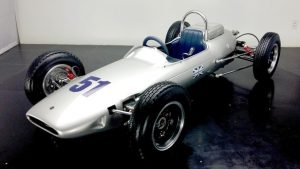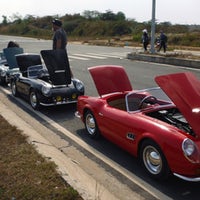- July 13, 2015
- Posted by: harrington
- Category: News
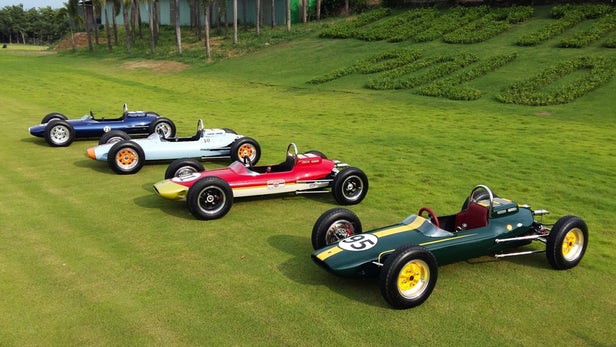
Source: New atlas
Half-scale cars are small enough and timid enough to stage a mini Grand Prix in your own backyard www.groupharrington.com
The Harrington Group‘s half-scale cars have been around for 13 years, with the entire fleet of classic look-alikes being completely reengineered two years ago and a new level of sophistication added to the designs. The latest release of a two-thirds scale 1960s Lotus 25 F1 lookalike could prove to be much more than just an exquisite toy for the wealthy though. It’s a low cost race car which could form the basis for a whole new sport with more relevance than karts.
There’s something incredibly endearing about a half-scale car. Like a baby or a kitten or a puppy, the first term you’ll invariably hear from any nearby females is “cute.” When I first wrote about them with the sale of the Pratte Collection in January, a colleague sent me a note saying, “nice job on the story with the poodle cars” and the term seemed so appropriate that we’ve all been referring to them as poodle cars ever since.
Poodle cars are small enough and timid enough to stage a mini Grand Prix in your own backyard, and they’re an ideal initial experience for a child to develop a first-hand relationship with inertia, momentum, yaw and traction when the human learning system is at its most receptive and can be calibrated for life.
It is no coincidence that Ayrton Senna, Michael Schumacher and Lewis Hamilton had karts at four years of age, while Fernando Alonso and Sebastian Vettel both started at three. Every Formula One driver on the grid in 2015 began driving a kart at an early age, and every champion since Damon Hill has learned his race craft in a kart (Damon cut his teeth motorcycle racing). For much more on the subject of the early development of motor coordination skills, see our article on Ayrton Senna’s Kart.
Those childhood lessons don’t just apply to going racing, because like riding a bicycle, once the skills have been imprinted on the brain at an early age, you’ll never forget what to do when your car starts to get sideways on a wet or icy public road several decades hence. Think of it as an insurance policy for your beloved “works replicas.”
Survey the wares on offer from the elite automotive auction houses (RM-Sothebys, Gooding & Co, Bonhams) at Goodwood, Retromobile, Pebble Beach or Amelia Island and you’ll notice many half-scale versions of classic cars in the listings among the full scale Jaguar E-Types, Jaguar XK120s, Mercedes-Benz 300SLs, Bugatti T35s and Porsche 356s and you’ll regularly see the Harrington Group name listed as the manufacturer. The cars pictured above are from Harrington Group’s first generation half-scale cars and it isn’t hard to recognize the classic lines of yesteryear and the natural appeal to sports car lovers.
Indeed, in my subsequent discussions with Harrington, it seems that the company’s older cars regularly fetch far more at auction than they did new. That’s mainly due to people being unaware that unlike the aforementioned full-scale exotica which was only produced in limited quantities many decades ago, the Harrington Group still produces half-scale cars and has significantly upgraded the sophistication of the newer product compared to the slightly older go-kart-based cars which regularly appear at auction.
Harrington Groups early days saw the production of Bugatti T35 lookalikes during the half-scale cars’ first generation, enough for a full grid during a staff family day(Credit: Harrington Group)
Harrington’s stainless steel retro-car bumper business began first and resulted from Redfearn’s years of experience restoring classic cars and recognizing the opportunities in the marketplace.
“Buying bumpers for classic cars was either very expensive or impossible before we started production of our stainless steel bumpers,” he told us. “You will never see a Citroen DS with rusty bumpers or a Rolls Royce with a rusty grille because those parts were made on the original vehicles from stainless steel, so we chose to make our bumpers in stainless steel too.”
“In 2002, we invested in the presses and tooling to produce stainless steel bumpers, and we now produce bumpers for over 300 classic cars plus kick plates, headlights housings, grills, and even fuel tanks, and the classic parts business has grown exponentially,” he continued. “We’re now shipping more then 300 sets of bumpers every month and as the interest in classic cars grows, so does our business.
“We focus on quality and our stainless steel is polished to the same finish as chrome, so we’re producing parts that look identical but are much stronger than the originals, withstand damage better, and they’re much easier and cheaper to repair if you do damage them.
“Stainless steel does not rust so we can confidently offer a lifetime anti-corrosion warranty. Centuries from now, if a car fitted with our bumpers has ended up in landfill, all they’ll find will be our bumpers.”
So how did the half-scale cars come about?
“I bought my nephew a rather expensive half-scale Mercedes and when I picked it up, I was rather dismayed at the quality. I drove home with it in the back of the truck, constantly looking over my shoulder at it and thinking about how this and that could be improved, and by the time I got home, I knew I could do much better than the car I’d just bought.
“When I moved to Vietnam, I started restoring scooters and cars and making parts for classic cars and I then began building the scaled cars too, hoping that one of the endeavors would work. Surprisingly, they all worked and we’ve experienced increasing success every year for the last 13 years.
“The first cars we produced were very simple. They were basically single-wheel-drive go karts with a body shell. The engine was in the rear and was difficult to work on there, they only had brakes on the rear, and they had limited ground clearance and no suspension. On top of all that, they were a bit heavy and a bit cramped for an adult to drive comfortably.”
As Redfearn has found, the half-scale car market is something like the McDonalds food business in reverse. Whereas children are the invisible drivers of business for the fast food chain, adults are the primary force behind buying decisions in the scale car marketplace.
“They had very beautiful body shells, but they were simple and basic. In one of your articles you wrote about a half-scale Porsche 356. That was one of ours built using the first generation architecture – gorgeous, but just a shadow of the quality we’re producing now.
“In 2010, we made the decision to stop producing the first generation models entirely. The other parts of the business were growing rapidly, and the old models were entirely hand built, all the parts for each model were individually machined, which required more craftsmen to scale up production, so we were limited in the number of cars we could produce.
“With all that labor involved in the construction, producing them had become very costly, and the cars had largely become a demonstration of our craftsmanship for the classic car marketplace. The other parts of our business were growing rapidly and were far more profitable, so although we loved making the scaled cars and were very proud of them, we decided to focus on the profitable parts of the business and stop production of the scaled cars entirely.
“I can remember having a conversation with my cousin about the decision, and he was so passionate in arguing that ‘you can’t stop producing them’ because they were so beautiful and gave so much joy to children and … then luck played a role.”
“No sooner had we made a decision to stop the production than the very next day one of the tech blogs in the United States, Like Cool, ran an post about our cars and other blogs started to pick the story up and it went viral,” said Redfearn. “In particular, when Jesus Dias from Gizmodo saw that post, he wrote a story entitled ‘I really want one of these mini-me sports cars,’ and the amount of response we were getting went crazy and more blogs saw it and picked up the story and we were suddenly getting over 200 enquiries a day.
“Inside a few weeks of those stories, we had two years of confirmed orders. Obviously that changed our perspective, so we decided to completely redesign the cars so they could be what we’d always wanted them to be – much more sophisticated technologically – yet design them so we could make them more affordably using much more advanced technology for the production processes while redeploying the skilled labor to places where it counted towards the final quality.”
Harrington half-scale cars Generation II
“The end result was that we cut down the number of models in the second-generation range, but increased the specification of the cars considerably. All four of the car-based models use the same basic chassis, suspension, differential and brakes, so there’s much more standardization of the components, but we ended up with a better product that’s easier to produce.
“Don’t get me wrong. Our first cars were great and we are very proud of our old models, because we’ve had the feedback to know how much joy they have given to children around the world, (he laughs) and of course the joy which adults derive from participating in nurturing those children. Our cars were awarded ‘the best Christmas present’ in 2009 by The Times (UK) newspaper.”
“It’s just that what we’re building now is so much better. The chassis and all of the mechanical components were redesigned using CAD, and the cars are no longer just toys.”
All of the cars run a 5 kW 120 cc four-stroke motor made by Loncin or Lifan, but as the cars only weigh a bit over 200 kg and have a small frontal area, in standard form, they’re good for 44 mph (72 km/h).
“For those who are starting out a young child in their first car, the engines can be restricted in power at the factory, or a 70 cc motor can be installed, which is quite a bit slower,” said Redfearn.
The engine and gearbox unit sourced from Loncin/Lifan uses a three-speed (plus reverse), semi-automatic transmission with a sequential gear change and is employed by a number of manufacturers in producing quad bikes.
Currently, the Harrington Group produces four models based on the new model architecture it has developed: the Cobra 289 (which looks for all the world like Shelby American’s classic 289 ci AC Cobra), the Spyder, the GB Spirit (an Aston Martin DB5 comes to mind) and the XK120 (with the gorgeous traditional lines of of the Jaguar XK120).
If you wish to use them for promotional or commercial purposes, or perhaps as pit transport for a race team, the cars can be optioned and painted to your specifications ex-factory, though obviously at a price. Some of the options include a spare wheel in the boot, hubcaps, a carpet set, leather upholstery and interior panels, a fitted car cover, pin stripes … all the way through to having the bodywork airbrushed to your own design.
The pedal box is also adjustable so that the same car can be used by a six year old or a six foot three parent, and the transition to the second generation of scaled cars was done with a great deal of thought for the parents who would share the fun, right down to the size of the seat required to comfortably accommodate said parents’ bottoms.
The two-thirds scale HG F1 car
Since getting the production of the Cobra 289, Spyder, XK120, and GB Spirit settled to his satisfaction, Redfearn has concentrated on bringing one of his pet projects to life: the two-thirds-scale Lotus 25 F1 car.
“Our aim was to produce a new class of racing car,” he said.
“I wanted to create something similar to a kart in terms of size and cost, but something far more relevant to the real world than a kart which has no suspension, a solid rear axle, no diff, no gears, rudimentary brakes and clutch … karts really have very little in common with a real racing car.”
Unlike karts, the F1 car is blessed with four-wheel disc brakes with four-pot calipers (with dual circuit, bias-adjustable hydraulics), fully-independent and fully adjustable suspension on each corner, limited slip differential and Harrington even developed its own cross-ply tires to enhance the sixties-style handling characteristics.
“With the Formula One cars we’ll be offering them with three forward gears plus reverse or four forward speeds. We’re using the same 120 cc engine but because the car is lower, lighter and more streamlined, we’ve seen 87 km/h with the standard motor and four-speed box.
“The OEM engines we use are essentially identical to Honda engines and hence have all the accessory modifications available which can raise the performance to any level you like.”
“You can buy reasonably-priced kits on eBay which increase the engine capacity to 197 cc, with high compression pistons, flowed heads, bigger carbs and there are also super- and turbo-charging kits for them, so the amount of performance is proportional to how much you want to spend on them and how much work you want to do.
“We don’t do the engine modifications for purchasers. They’ll need to do that themselves, but we’ve seen what people have done and heard stories of the sort of performance available and well over 100 mph is achievable in one of our cars using the same basic engine and bolt on parts.”
I haven’t driven one of these cars, much less the recently-released HG F1 Lotus lookalike, but talking to Redfearn leaves me in no doubt as to what they handle like. He’s a classic car constructor and aficionado and when he discusses the drivability of the cars, the passion shines through.
“Compared to a real kart, they’re heavy and underpowered in standard form, but with the handling, suspension and brakes, they’re often much faster around a rough circuit. The road cars all drift beautifully, but the HG F1 car is another level again. It’s a thoroughbred with balance and feel. It’s exactly what we set out to create.”
Leave a Reply
You must be logged in to post a comment.





